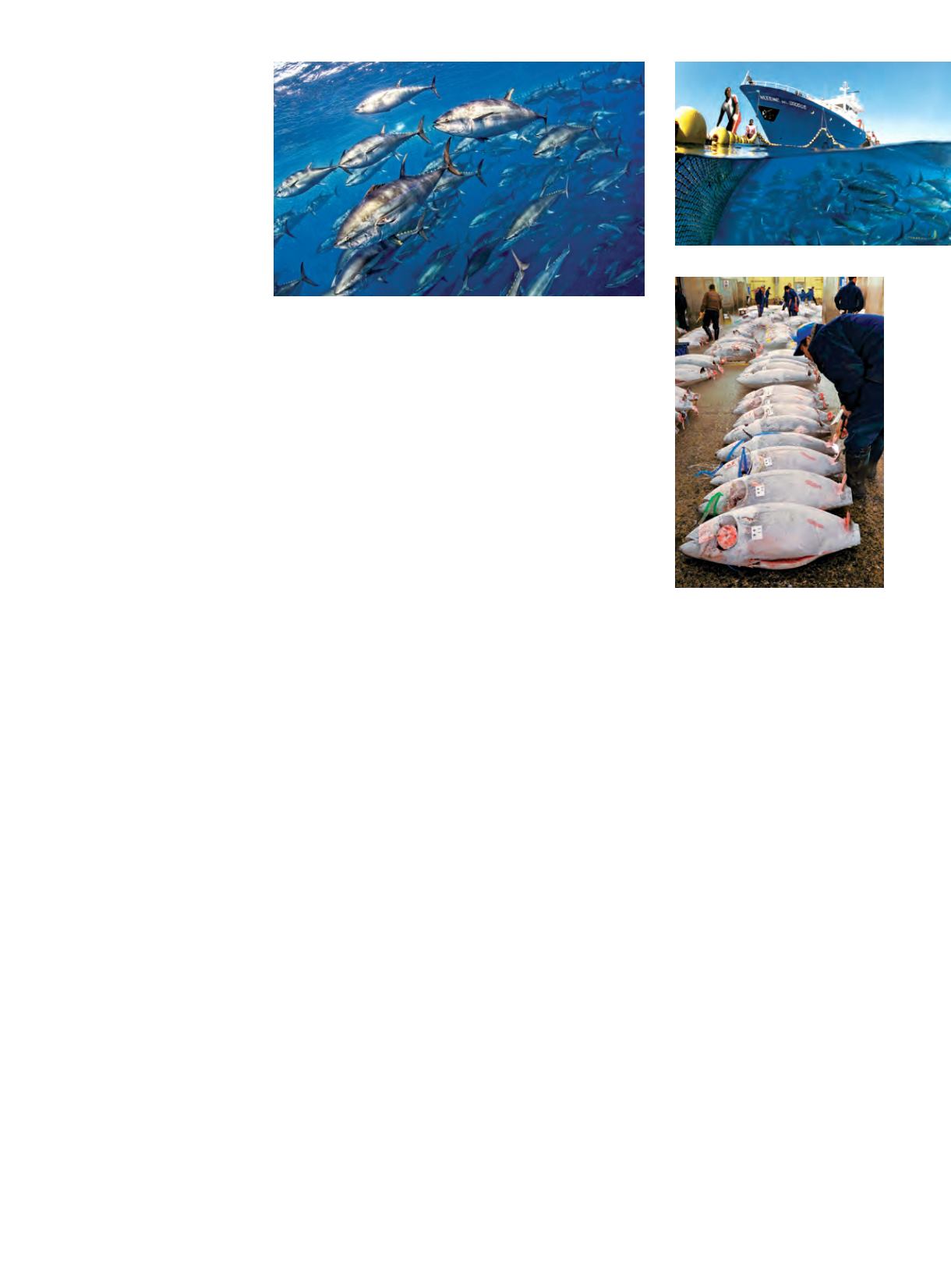
LIFE AQUATIC
//
42
|
WINTER 2014
Think of it as an all-you-can-
eat sushi buffet, except in
this case it’s the sushi that’s
stuffing its face.
As tuna approach
adulthood, the life history
varies dramatically among
tuna species (and sometimes
even within species). Some
tunas stick closer to the coast, while others prefer deeper
waters. Some never stray far from where they were born.
Atlantic bluefin born in the Gulf of Mexico regularly
migrate thousands of miles to the Mediterranean Sea,
only to return to their birthplace to spawn many years
later. “When you think about how they start their lives
and are swept very quickly into the open ocean, the
fact that they find their way back is truly remarkable,”
said David Secor, a tuna biologist with the University of
Maryland Center for Environmental Science.
Most tunas reach sexual maturity between two and
five years of age, with the exception of the bluefin
species, which can take anywhere from eight to 15
years to begin spawning. This topic has received
considerable attention in recent years in light of
widespread concern over the sustainability (or lack
thereof) of tuna fisheries and the impact of overfishing
on tuna populations around the globe.
FEEDING FRENZY
Humans have been catching and eating tuna for
thousands of years. In the Mediterranean Sea the
earliest evidence of bluefin tuna fishing has been
estimated at roughly 7,000 B.C., with large-scale trap
fishing developed by the Phoenicians around 2,000
B.C. “Tuna built a lot of civilizations around the
globe,” Block says. “It’s only recent generations that
have begun to treat it like a commodity.”
Within the past hundred years or so, our craving for
tuna in its many forms has ballooned into a full-blown
addiction. Canned tuna, which debuted in the U.S.
in 1903, succeeded in turning these proud fish into a
bulk commodity that for decades reigned as the most
popular seafood in America.
Then there’s the global market for bluefin meat,
which is prized in sushi restaurants around the world
(especially in Japan, where most top-quality bluefin ends
up). Sold under names such as otoro and hon maguro,
the rich, fatty flesh ranges in hue from soft pink to
deep red, looking more like filet mignon than Filet-O-
Fish. Bluefin can fetch astronomical prices at Tokyo
fish markets; for example,
a 489-pound specimen
sold for a mind-boggling
$1.78 million at auction in
January 2013 — more than
$3,600 per pound.
This gourmet feeding
frenzy has been bad news
for the future of bluefin
populations, which
continue to be overfished
despite numerous scientific
reports from academic
institutions and conservation
groups around the world
warning that they are on the
brink of collapse.
BACK FROM THE BRINK?
There are some signs, however, that tuna’s fortunes
could be changing for the better. Block said she is
encouraged by recent efforts to influence governments
and consumers to take pressure off the most heavily
overfished species such as Atlantic bluefin, which by
most estimates has declined by more than 70 percent
across all populations since 1970. “I think the tide is
changing quickly,” she said. “What we need to do is
figure out how to produce the tuna that the world
needs without depleting wild populations.”
Tuna aquaculture, or “ranching,” certainly has
potential in that regard, although critics say current
practices do little to alleviate overfishing and even
create greater burden on tuna stocks. Block said
she is hopeful that will change as the science and
management continue to improve.
For now, though, conservation-minded consumers
will want to steer clear of bluefin. And the next time
you find yourself scarfing down a spicy tuna roll (almost
certainly yellowfin or bigeye) or a tuna fish sandwich
(albacore or skipjack), spare a moment to think about
all the things that make these fish so amazing.
AD
ANTONIO BUSIELLO
Humans’ insatiable appetite
for tuna has put the future of
some species in question.
PHOTOMICK/ISTOCKPHOTO
ANTONIO BUSIELLO


